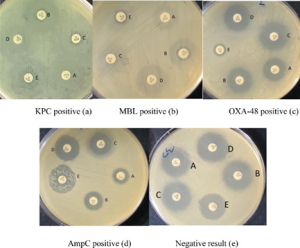Please click the frequently asked questions below for further information and IPC precautions required:
What is CPO /CPE?
CPO/CPE stands for Carbapenemase Producing Organism/ Carbapenemase Producing Enterobacteriaceae. This is a group of bacteria, e.g. E. coli, Klebsiella and Enterobacter, which are very resistant to antibiotics (including antibiotics called Carbapenems). These bacteria normally live harmlessly in the bowel, however if they get into another area such as the bladder or bloodstream they can cause infection.
Infection caused by a CPO/CPE can be difficult to treat as these bacteria can produce enzymes (proteins/chemicals) which destroy most of the available antibiotics. Carbapenem antibiotics are a powerful group of antibiotics that can only be given in hospital directly into the bloodstream.
Carbapenem-resistant organisms (CROs) are a group of organisms (bacteria) that have become resistant to more than 10 antibiotics in a class of antibiotics called carbapenems. CPOs are CROs that make an extra enzyme (carbapenemase) that make it easier to spread in healthcare settings and even harder to treat than some CROs that don’t make the special enzyme.

Can CPO/CPE cause harm?
For most patients, CPOs/CPEs live harmlessly in the bowel and do not cause infection. Sometimes CPOs/ CPEs can cause infection in patients, e.g. when they need receive invasive healthcare interventions. This can include venepuncture, surgery, catheter insertion etc.
CPOs/CPEs can cause infections, such as kidney infections, wound infections or in severe cases, blood infections. Clinical staff need to know as soon as possible if a patient is carrying CPO/ CPE so that they can be managed appropriately and the most effective antibiotics can be chosen to treat any infection.

Why is this information important?
If NIAS staff are aware that the patient has a suspected or confirmed case this should be communicated to the Control Room (Emergency or Non-emergency as appropriate) and the staff in the receiving unit when transferring the patient to ensure effective patient care and management.
Some patients have been supplied with an Alert card if they are known to be colonised with CPO / CPE. This card will provide advice on their management.
How is it spread?
Patients who have already taken a lot of antibiotics are more at risk of having a CPO/CPE. The more our body’s normal bacteria are exposed to antibiotics the more likely they are to develop resistance. Therefore antimicrobial stewardship is a key element in preventing CPO/ CPEs.
CPOs/CPEs can spread between patients either through contact with a patient known to have CPO/CPE or by touching the environment that has been occupied by a patient with CPO/CPE e.g. patient equipment, stretchers, hand rails, straps etc.
It can also be spread through staff’s hands if staff do not adhere to the 5 moments of Hand Hygiene (HH) using the 7 step technique. It is also essential that staff use PPE appropriately ensuring that gloves are used and changed appropriately with HH. This will help protect both staff and patients from transmission of CPOs/CPEs.
IPC Precautions
- Contact precautions should be used
- Hand Hygiene should be completed as per the 5 moments in line with usual practice.
- Eye protection should always be risk assessed and used with any patient where there is a risk of splashes including spitting and productive coughing.
- Gloves and Aprons should be worn.
- A long sleeved gown may be required if there is prolonged contact with patients during personal care where the staff’s forearms and uniform may be contaminated.
- The patient should be transported via ambulance (eg. PCS) with no other patients present where possible. Individual cases can be discussed with the IPC team and a risk assessment can be made.
- Laundry should be treated as contaminated, placed into an alginate bag and placed into a red laundry bag.
What cleaning is required?
All equipment and the ambulance should have a Decontamination clean paying particular attention to touch points.
Any equipment which can be discarded (eg. Single use items which may have been contaminated) should be disposed of if there has been any possible contamination.
Do staff need any prophylaxis or follow up?
Staff do not need to be followed up after caring for a patient with CPO / CPE.
